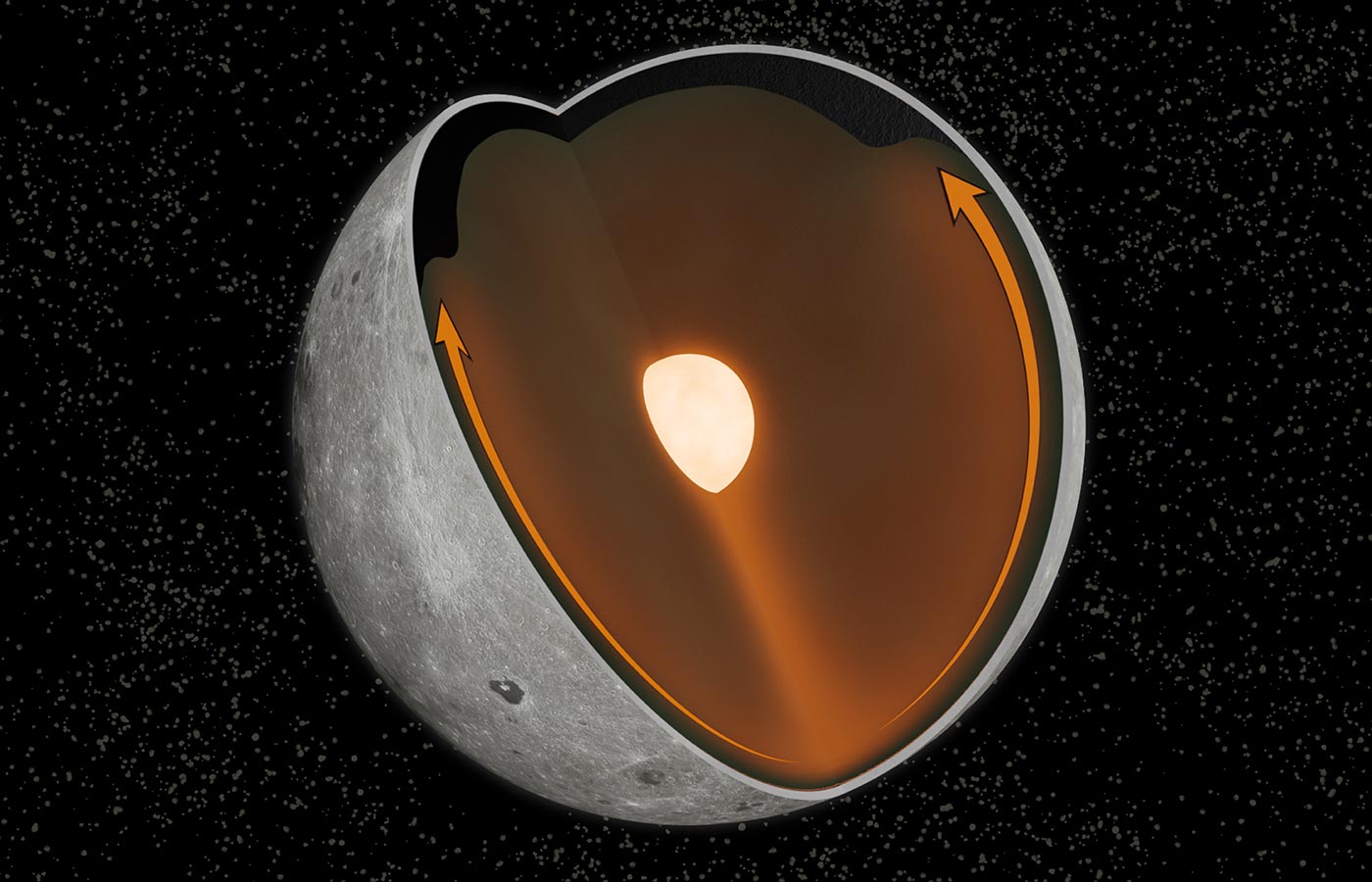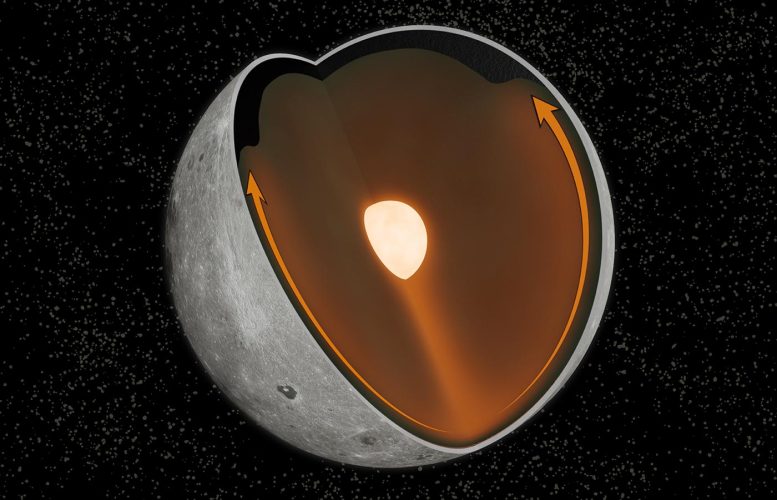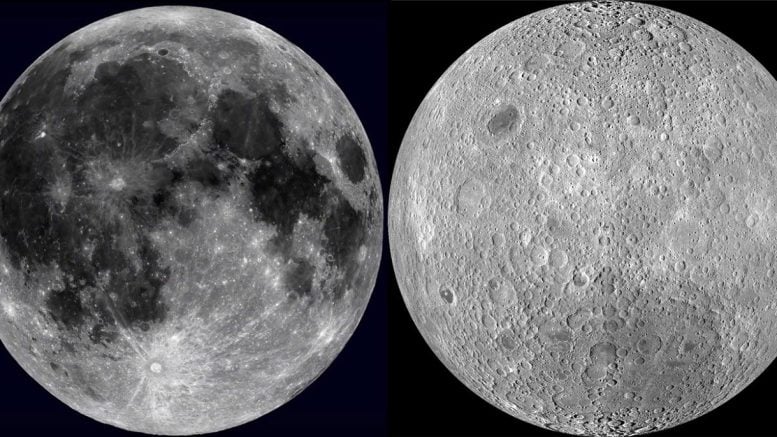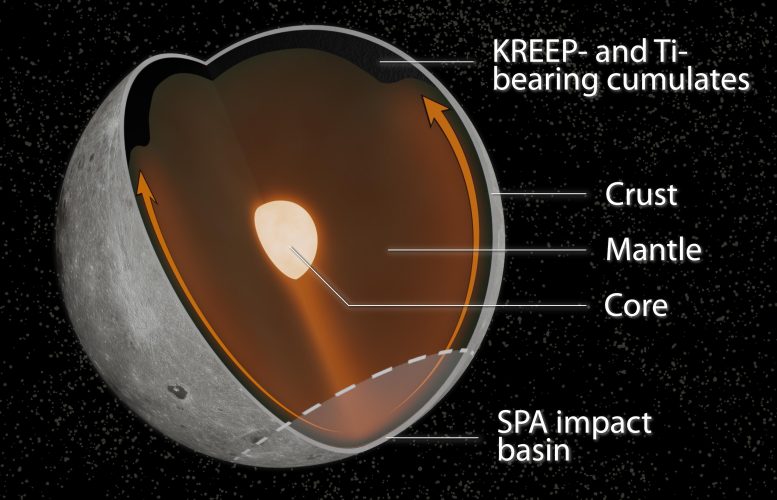Impactul antic colosal legat de diferențele dintre părțile apropiate și îndepărtate ale Lunii


Un nou studiu dezvăluie că o coliziune străveche pe polul sudic al Lunii a schimbat modelele de convecție în mantaua lunară, concentrând o suită de elemente producătoare de căldură pe partea apropiată. Aceste elemente au jucat un rol în crearea imensei iape lunare vizibile de pe Pământ. Credit: Matt Jones
Noi cercetări arată cum impactul care a creat bazinul Polul Sud al Lunii – Aitken este legat de contrastul puternic în compoziție și aspect dintre cele două părți ale Lunii.
Fața pe care Luna o arată Pământului arată mult diferită de cea pe care o ascunde pe partea sa îndepărtată. Partea apropiată este dominată de iapa lunară – rămășițele vaste, de culoare închisă, ale fluxurilor de lavă antice. Pe de altă parte, partea îndepărtată a craterului este practic lipsită de caracteristici de iapă la scară largă. De ce cele două părți sunt atât de diferite este unul dintre cele mai durabile mistere ale Lunii.
Acum, cercetătorii au o nouă explicație pentru Luna cu două fețe – una care se referă la un impact uriaș cu miliarde de ani în urmă, lângă polul sudic al Lunii.
Un nou studiu publicat în revista Science Advances arată că impactul care a format bazinul gigant al Lunii Polul Sud-Aitken (SPA) ar fi creat un val masiv de căldură care sa propagat prin interiorul lunar. Acea plună ar fi transportat anumite materiale – o suită de Pământuri rare și elemente producătoare de căldură – pe partea apropiată a Lunii. Acea concentrare de elemente ar fi contribuit la vulcanismul care a creat câmpiile vulcanice din apropiere.

Partea apropiată a Lunii (stânga) este dominată de vaste depozite vulcanice, în timp ce partea îndepărtată (dreapta) are mult mai puține). De ce cele două părți sunt atât de diferite este un mister lunar de durată. Credit: Universitatea Brown
„Știm că impacturi mari precum cel care a format SPA ar crea multă căldură”, a spus Matt Jones, Ph.D. candidat la Universitatea Brown și autorul principal al studiului. „Întrebarea este cum afectează această căldură dinamica interioară a Lunii. Ceea ce arătăm este că, în orice condiții plauzibile la momentul în care s-a format SPA, ajunge să concentreze aceste elemente producătoare de căldură pe partea apropiată. Ne așteptăm ca acest lucru să contribuie la topirea mantalei care a produs fluxurile de lavă pe care le vedem la suprafață.”
Studiul a fost o colaborare între Jones și consilierul său Alexander Evans, profesor asistent la Brown, împreună cu cercetători de la Universitatea Purdue, Laboratorul de Științe Lunare și Planetare din Arizona, Universitatea Stanford și[{” attribute=””>NASA’s Jet Propulsion Laboratory.

A new study reveals that an ancient collision on the Moon’s south pole changed patterns of convection in the lunar mantle, concentrating a suite of heat-producing elements on the nearside. Those elements played a role in creating the vast lunar mare visible from Earth. Credit: Matt Jones
The differences between the near and far sides of the Moon were first revealed in the 1960s by the Soviet Luna missions and the U.S. Apollo program. While the differences in volcanic deposits are plain to see, future missions would reveal differences in the geochemical composition as well. The nearside is home to a compositional anomaly known as the Procellarum KREEP terrane (PKT) — a concentration of potassium (K), rare earth elements (REE), phosphorus (P), along with heat-producing elements like thorium. KREEP seems to be concentrated in and around Oceanus Procellarum, the largest of the nearside volcanic plains, but is sparse elsewhere on the Moon.
Some scientists have suspected a connection between the PKT and the nearside lava flows, but the question of why that suite of elements was concentrated on the nearside remained. This new study provides an explanation that is connected to the South Pole–Aitken basin, the second largest known impact crater in the solar system.
For the study, the researchers conducted computer simulations of how heat generated by a giant impact would alter patterns of convection in the Moon’s interior, and how that might redistribute KREEP material in the lunar mantle. KREEP is thought to represent the last part of the mantle to solidify after the Moon’s formation. As such, it likely formed the outermost layer of mantle, just beneath the lunar crust. Models of the lunar interior suggest that it should have been more or less evenly distributed beneath the surface. But this new model shows that the uniform distribution would be disrupted by the heat plume from the SPA impact.
According to the model, the KREEP material would have ridden the wave of heat emanating from the SPA impact zone like a surfer. As the heat plume spread beneath the Moon’s crust, that material was eventually delivered en masse to the nearside. The team ran simulations for a number of different impact scenarios, from dead-on hit to a glancing blow. While each produced differing heat patterns and mobilized KREEP to varying degrees, all created KREEP concentrations on the nearside, consistent with the PKT anomaly.
The researchers say the work provides a credible explanation for one of the Moon’s most enduring mysteries.
“How the PKT formed is arguably the most significant open question in lunar science,” Jones said. “And the South Pole–Aitken impact is one of the most significant events in lunar history. This work brings those two things together, and I think our results are really exciting.”
Refernece: “A South Pole–Aitken impact origin of the lunar compositional asymmetry” by Matt J. Jones, Alexander J. Evans, Brandon C. Johnson, Matthew B. Weller, Jeffrey C. Andrews-Hanna, Sonia M. Tikoo and James T. Kean, 8 April 2022, Science Advances.
DOI: 10.1126/sciadv.abm8475

„Creator. Amator de cafea. Iubitor de internet. Organizator. Geek de cultură pop. Fan de televiziune. Mândru foodaholic.”
